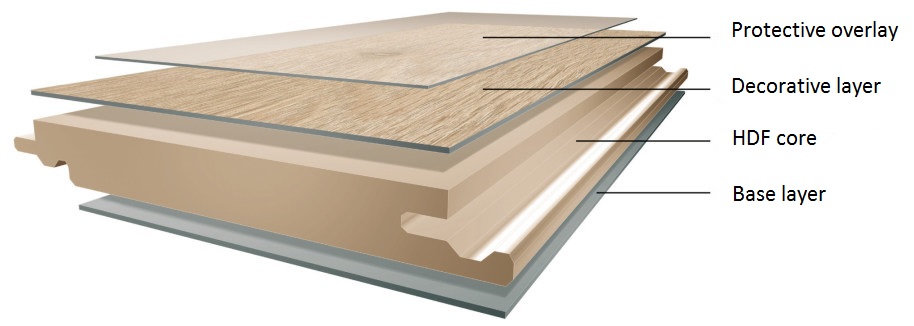Guide to Buying Laminate Flooring
Reading time: 3 minutes
How is laminate flooring made?
Laminate flooring boards are usually made up of four distinct layers, which are fused to make a durable and attractive floor covering that mimics the look of solid wood flooring. Let’s take a closer look at these layers, starting at the top and working our way down:
Scratch-resistant wear layer
This top surface is important for two reasons. Firstly, it protects the boards from knocks, dents and everyday wear and tear. Secondly, it has a UV filter to stop the photographic layer beneath it from fading due to sunlight. On some premium laminate flooring boards, this might also be an embossed protective layer for added texture and authenticity.
Decorative layer
This is an image that can showcase any type of surface. It’s a high-resolution, photographic image to replicate flooring styles, which can include stone flooring and other graphics. Most commonly, this image would show a wood surface, with the oak laminate flooring look being typically the most popular.
Core layer
HDF (High-Density Fibreboard) is made from a mix of softwood fibres and wax, with resin to bind it all together through pressure and heat. HDF is tough, durable and can be cut to very exacting measurements through micron milling techniques. Core layers can also be made of other materials, such as MDF.
Stabilising backing layer
This impermeable bottom layer helps to keep the whole board stable, balanced and works as a moisture barrier. You might also find that backing layers have their own underlayment for cushioning. However, this doesn’t always mean that further underlay isn’t required; this depends on other factors, such as sound proofing or damp proofing.
Laminate flooring specifications:
Price range: approx. £12 - £45 per m2
Typical thickness: 8mm – 12mm
Board widths: 190mm (average)
Underlay: required – avoid laying directly on subfloor
Fitting: click-to-fit systems
Underfloor heating: compatible
Fitting laminate flooring
With laminate flooring, you’re most likely to come across a tongue and groove click system. This is a simple way of fitting flooring panels that doesn’t require a great deal of expertise, and can deliver stable coverage while being flexible enough to be detached and re-laid, permitting for mistakes. The result is a seamless connection between panels for a pleasing, professional look.
Laminate flooring continues to be a popular choice due to its versatility and affordability, but it is by no means the only option available. For example, you might want to compare Laminate to Vinyl flooring, as either options can be suitable for similar home or commercial properties. For further guidance in choosing the right flooring for your needs, head over to our Best Flooring Hub for useful guides to help in your decision making.
Order laminate flooring online, or shop for other flooring and accessories available from Travis Perkins today.
Disclaimer: The information contained on this page is intended as an overall introduction and is not intended as specific advice from a qualified professional. Travis Perkins aims to avoid, but accepts no liability, in the case that any information stated is out of date.






